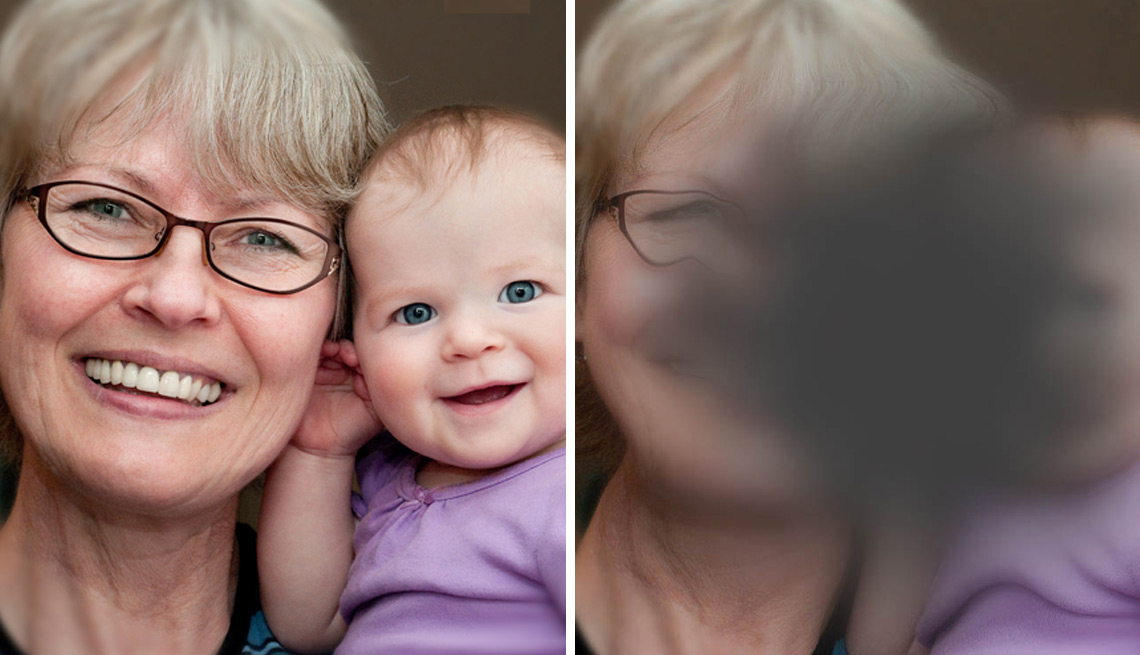10 Eye-Opening Vision Facts on AMD – Get the Full Picture!
February is Low Vision Awareness Month
A change in your vision is not always a normal sign of aging — it could be a sign of something much more serious, but treatable.1 February is Low Vision Awareness Month, the perfect time to be proactive about your eye health.
Did you know?
Approximately 14 million Americans are living with age-related macular degeneration (AMD), the leading cause of vision loss in adults over 50.1,2 AMD is an eye condition that affects the macula, the part of the eye responsible for sharp central vision.1 The macula makes it possible to read and see objects in front of you clearly.

Source and Copyright: © 2018 by The Angiogenesis Foundation, Inc., All Rights Reserved
Example of normal vision versus vision impacted by age-related macular degeneration.
New research among men and women over the age of 60 showed that many people have early signs of AMD, but don’t know it.3 Although there is no cure for AMD, treatment options are available, and the sooner it is detected, the better the odds are of protecting against vision loss.1,4
Get the full picture
Here are 10 things you need to know about AMD and how to help protect your vision:
1. AMD is an eye disease that progresses through several stages
Nine out of ten people with AMD have the early or intermediate stages of the disease.5 While they may not experience vision loss, they still need to be monitored by their doctors. Why? For 1.2 million Americans, AMD progresses to a condition called “Wet” AMD, the most advanced stage, which may lead to severe vision loss.6,7 It’s called “Wet” because it refers to the abnormal growth and leakage of blood vessels in the eye that can cause vision problems.1
2. Wet AMD symptoms are more than "aging eyes"
While earlier forms of AMD may show no symptoms, Wet AMD symptoms can appear and worsen quickly.1 Wet AMD symptoms are often painless and may include blurriness in the center of vision, blind spots or patches, straight lines that look wavy or colors that look dull or washed out.1,8,9

SOURCE AND COPYRIGHT: © 2018 BY THE ANGIOGENESIS FOUNDATION, INC., ALL RIGHTS RESERVED
Example of normal vision versus vision impacted by age-related macular degeneration.
3. Wet AMD can cause severe vision loss
You may think vision loss means a person’s eyesight goes black (like when you close your eyes), but the type of vision loss caused by Wet AMD is different. Someone with Wet AMD may be able to see just fine out of the corner of their eyes, but may have trouble with activities that require central vision, such as reading, driving at night, recognizing faces and watching TV.1 If you’re having trouble with these activities, it is important to see an eye doctor immediately.
4. Wet AMD can impact quality of life
Vision loss from Wet AMD can impact independence by making everyday tasks and activities, like seeing pills, cooking or reading, more difficult or even impossible. Talk to your doctor about getting screened for Wet AMD because there are effective treatment options available that can protect your eyes.
5. You may be at risk for Wet AMD
Anyone over the age of 50 has a higher risk of developing Wet AMD.1 The risk is even higher if you have a family member with AMD. Additionally, Wet AMD is more common in women, among Caucasians and among those who smoke. If you are at higher risk, talk to your eye doctor to develop a plan for early detection.
Dr. William W. Li, President and Medical Director of the nonprofit Angiogenesis Foundation, says: "Today, it’s possible to help save your vision by detecting and treating Wet AMD as early as possible. The key is getting your eyes checked by an eye care professional."
6. Your best defense is a regular eye exam
Vision loss from Wet AMD can be managed if it is caught early.4 A surefire way to stay ahead of the condition is to have an annual dilated eye exam – a common test where a doctor examines the back of the eye for signs of AMD.10 You can also monitor your eye health at home with an easy-to-use vision test called an Amsler Grid. Using the Amsler Grid can help you detect small changes in vision that may be signs of Wet AMD.
7. Wet AMD can be treated
If you have Wet AMD, treatment options are available, including laser and anti-VEGF (vascular endothelial growth factor) treatments. Talk to your doctor about treatment options that may be right for you.1,11
8. Treatments for Wet AMD are done in your eye doctor’s office
If your doctor prescribes treatment, make sure to ask what to expect, including the risks and benefits, how often you should come in for treatments and how you can be made to feel as comfortable as possible.
9. Sticking with your treatment plan is critical if you have Wet AMD
To help protect against vision loss, follow your doctor’s recommended treatment schedule.1 Every treatment may help make a difference! It’s important to stick to the plan your doctor prescribes and avoid missing or delaying appointments.
10. Remember, you’re not alone
Your doctor and their staff are there to help. To help prepare for your appointments, write down any concerns and questions you may have, such as: What treatments are right for me? What are the risks and benefits? What do I do if I’m noticing changes in my vision? How often do I need to receive treatment? And remember: it is helpful and important to have a spouse, family member, or friend come with you to your appointments and drive you home after a treatment.
Meet Eloine from Massachusetts — She is a 79-year old fighter. Eloine has had more than her fair share of health challenges, including beating cancer three times and overcoming a hearing impairment. When her doctor told her she had AMD, she decided to tackle the disease head-on. Eloine was one of the first to use an FDA-approved home-monitoring device clinically proven to identify even the smallest changes in vision. This device notified her immediately when her vision changed, indicating that she had progressed to Wet AMD. Early detection allowed Eloine to get treatment right away.
Eloine is committed to receiving treatment on a regular schedule and has not experienced vision loss. She continues to thrive doing the things she loves most. Follow Eloine’s lead and schedule an eye exam today.
Looking for resources to help you manage Wet AMD?
You can also get tips for living with Wet AMD delivered right to you by following the Look to Your Future Facebook page. Another great resource is the Angiogenesis Foundation’s ScienceOfAMD.org.
Make a commitment to what matters – your vision. Don’t wait until there is a problem. A visit to the eye doctor can be the first step in proactively managing your eye health.
Learn more and sign up for new tips and resources at LookToYourFuture.com, on Facebook or ScienceOfAMD.org.
This article was written in collaboration with the Angiogenesis Foundation.
References
- Facts about age-related macular degeneration. National Institutes of Health, National Eye Institute Web site. https://www.nei.nih.gov/health/maculardegen/armd_facts. Accessed January 17, 2018.
- What is macular degeneration. Macular Degeneration Partnership Web site. http://amd.org/what-is-macular-degeneration/. Accessed January 17, 2018.
- Neely DC, Bray KJ, Huisingh CE et al. Prevalence of undiagnosed age-related macular degeneration in primary eye care. JAMA Ophth. 2017 Jun 1;135(6):570-575.
- Prevention of age-related macular degeneration: eye examinations. BrightFocus Foundation Web site. https://www.brightfocus.org/macular/article/prevention-age-related-macular. Accessed January 17, 2018.
- Dry macular degeneration. American Macular Degeneration Foundation Web site. https://www.macular.org/dry-amd. Accessed January 17, 2018.
- The eye disease prevalence research group. Prevalence of age-related macular degeneration in the United States. Arch Ophthalmol. 2004;122:564-572.
- Wet AMD. Macular Degeneration Partnership Web site. http://amd.org/what-is-macular-degeneration/wet-amd/. Accessed January 17, 2018.
- Macular degeneration: understanding your disease – signs & symptoms. BrightFocus Foundation Website. https://www.brightfocus.org/macular/symptoms-and-signs. Accessed January 17, 2018.
- Macular degeneration. National Organization for Rare Disorders (NORD) Web site. https://rarediseases.org/rare-diseases/macular-degeneration/. Accessed January 17, 2018.
- Symptoms of age-related macular degeneration (AMD) and how it is diagnosed. American Foundation for the Blind, VisionAware Web site. http://www.visionaware.org/info/your-eye-condition/age-related-macular-degeneration-amd/symptoms-of-amd/125. Accessed January 17, 2018.
- Macular degeneration treatment: How is AMD treated? American Academy of Ophthalmology (AAO EyeSmart) Web site. https://www.aao.org/eye-health/diseases/amd-treatment. Accessed January 17, 2018.


